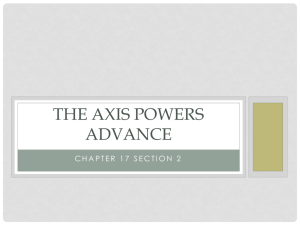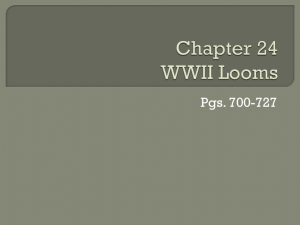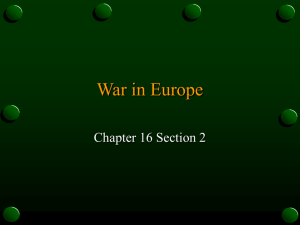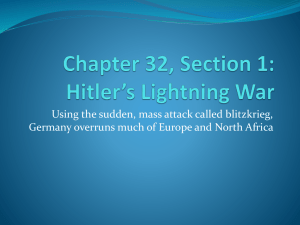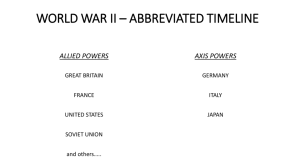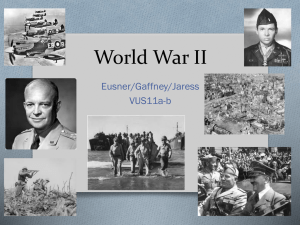World War II
advertisement
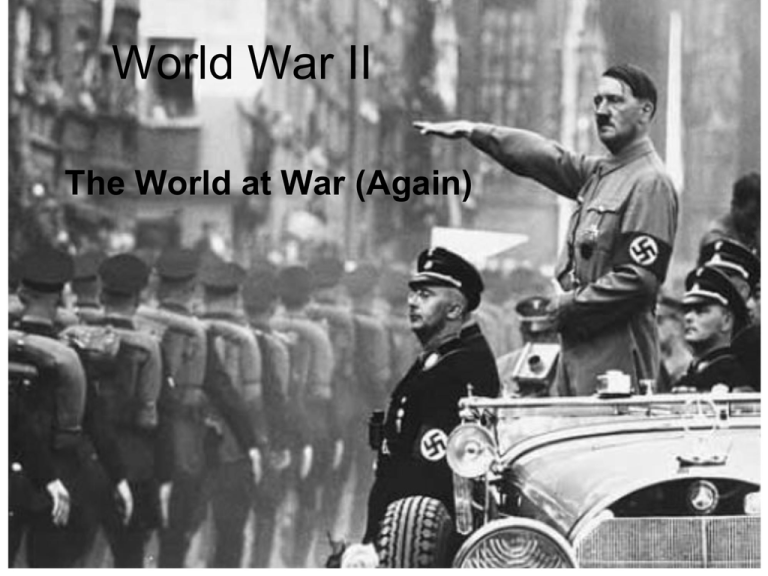
World War II The World at War (Again) World Leaders Before World War II • Adolf Hitler – Nazi leader of Germany • Benito Mussolini – Fascist leader of Italy • Joseph Stalin – Communist leader of the Soviet Union * Japan was controlled by their military World Leaders Before World War II • Neville Chamberlin / Winston Churchill – Prime Ministers of Britain • Franklin Roosevelt / Harry Truman – President of the U.S. Hitler’s Aggression Prior to WWII • Removal of Germany from the League of Nations • Began building up the German military • Invaded the Rhineland (a demilitarized zone on the French border) • Supported Francisco Franco in the Spanish Civil War • Conquered Austria • Conquered the Sudetenland (part of Czechoslovakia) American Neutrality • The U.S. passes four neutrality acts to keep us out of the growing tensions in Europe Munich Conference • Allied nations and the League of Nations were concerned with Germany’s growing power and aggressiveness • War seemed near when Hitler invited the leaders of France and Britain to a meeting in Munich, Germany • The Munich Agreement granted Hitler control of the Sudetenland and he promised no further aggression Appeasement • The practice of granting the demands of an aggressor to keep peace Six months later, Hitler invaded and conquered the rest of Czechoslovakia. Allied nations began to realize that war was imminent while Hitler (backed by Italy and Japan) set his sights on Poland. Nonaggression Pact • Hitler and the Soviet Union entered into a nonaggression pact in August of 1939. • The both agreed not to attack each other and to split Poland once it was conquered. Hitler wanted to remain friendly with the Soviet Union until he was ready to invade. He was trying to avoid another two-front war. September 1, 1939 • Hitler invaded Poland using his blitzkrieg (lightning war) tactics. • Poland was crushed in just three weeks. • The Soviet Union invaded the country from the east during the last week of fighting. • Two days after the invasion, Britain and France declared war on Germany to begin WWII. Time Line of WWII Events • Phony War (sitzkrieg) • April 9, 1940 – Hitler surprise attacks Denmark and Norway • He then attacked the Low Countries (The Netherlands, Belgium, and Luxembourg) France Falls • French and British troops set up along the Maginot line anticipating the German invasion which came through the Ardennes Forest. • Dunkirk EvacuationGreatest evacuation of troops in history; 330,000 British, French, and Belgian troops in less than a week • France fell to Germany in June 1940 and Hitler began the Battle of Britain. Disappearing Neutrality • Britain pressures FDR to help them • Fourth Neutrality Act is passed (cash and carry) • Destroyer Deal – weapons for military base leases • Congress increased defense funds and passed the first peacetime military draft U.S.S.R. Becomes an Allied Power • In June of 1941, Germany invaded the Soviet Union breaking the Nonaggression pact from earlier in the war. • Stalin became a reluctant Allied Power. • Hitler would now face a two front war which would give Britain some relief. • Britain successfully held off the Germans in the Battle of Britain and the Soviet Union trapped the German troops deep inside Russia during the winter and forced them to surrender. • Russia lost more troops than any other Allied nation (over 8 million killed in battle) • Lend-Lease Act (March 11, 1941) – Amended the neutrality acts to allow the president to lend or lease military equipment and supplies to countries who were vital to the defense of the U.S. – $1 billion in aid was sent to Britain and her allies in October ($50 billion before the U.S. entered the war) • Quarantine Speech Japanese/American Relations • Japan had taken over large sections of China, Indochina, and many Pacific islands • The U.S. had placed an oil embargo on Japan and frozen their assets in the U.S. • FDR was trying to end Japanese aggression in Southeast Asia Pearl Harbor Attack December 7, 1941 • Surprise Japanese attack on a U.S. naval base in Hawaii that took place early on a Sunday morning • 2,403 Americans killed/1,178 wounded • 21 ships were damaged and 300 aircraft destroyed • This was the event that brought the U.S. officially into World War II on Dec. 8, 1941 (Germany and Italy declared war Dec. 10) America at War • The U.S. adopted a Europe-first strategy and sent troops to North Africa to help protect the Suez Canal which was being threatened by German troops. • Dwight D. Eisenhower- the leader of the U.S. forces in Europe and North Africa. • Germany sought to cut off the Allied Powers’ oil supply from the Middle East. • U.S. and British forces in North Africa held firm at the Battle of El Alamein and protected the Suez Canal. • German troops were driven into Italy where fighting continued until late in the war. D-Day • The Soviet Union was pushing for a second front in Europe to help divert some of the German troops. • On June 6, 1944, Allied troops invaded Nazioccupied France on the Normandy coast giving Stalin his second European front. D-Day • D-Day (Decision Day) was the code name for the first day of Operation Overlord which was the largest seaborne invasion in history • 156,000 soldiers in 6,939 vessels crossed the English channel catching the Germans completely off guard. • German resistance was heavy in places but the invasion went well. • German troops were then gradually pushed back into Germany to end the war. Battle of the Bulge • Germany’s last chance to win the war came in Belgium (December, 1944). • Germany tried to break the enemy lines but only created a huge bulge in them. • Casualties were high because of the intense fighting. • Hitler lost and continued his retreat into Germany. Fall of Berlin (April-May,1945) • Three Soviet Army groups attacked the city from the east, west, and north. • Soviets lost 81,116 men while Germany lost 458,080 men. • It was one of the bloodiest battles in history. • Hitler and many of his followers committed suicide before the end of the war. V-E Day (Victory in Europe Day) • Berlin fell on May 2, but fighting continued until May 8, 1945 (V-E Day), when the Germans surrendered to the Allied troops ending WWII in Europe. • The Germans fought until they could surrender to the British or U.S. troops instead of the Soviets.
